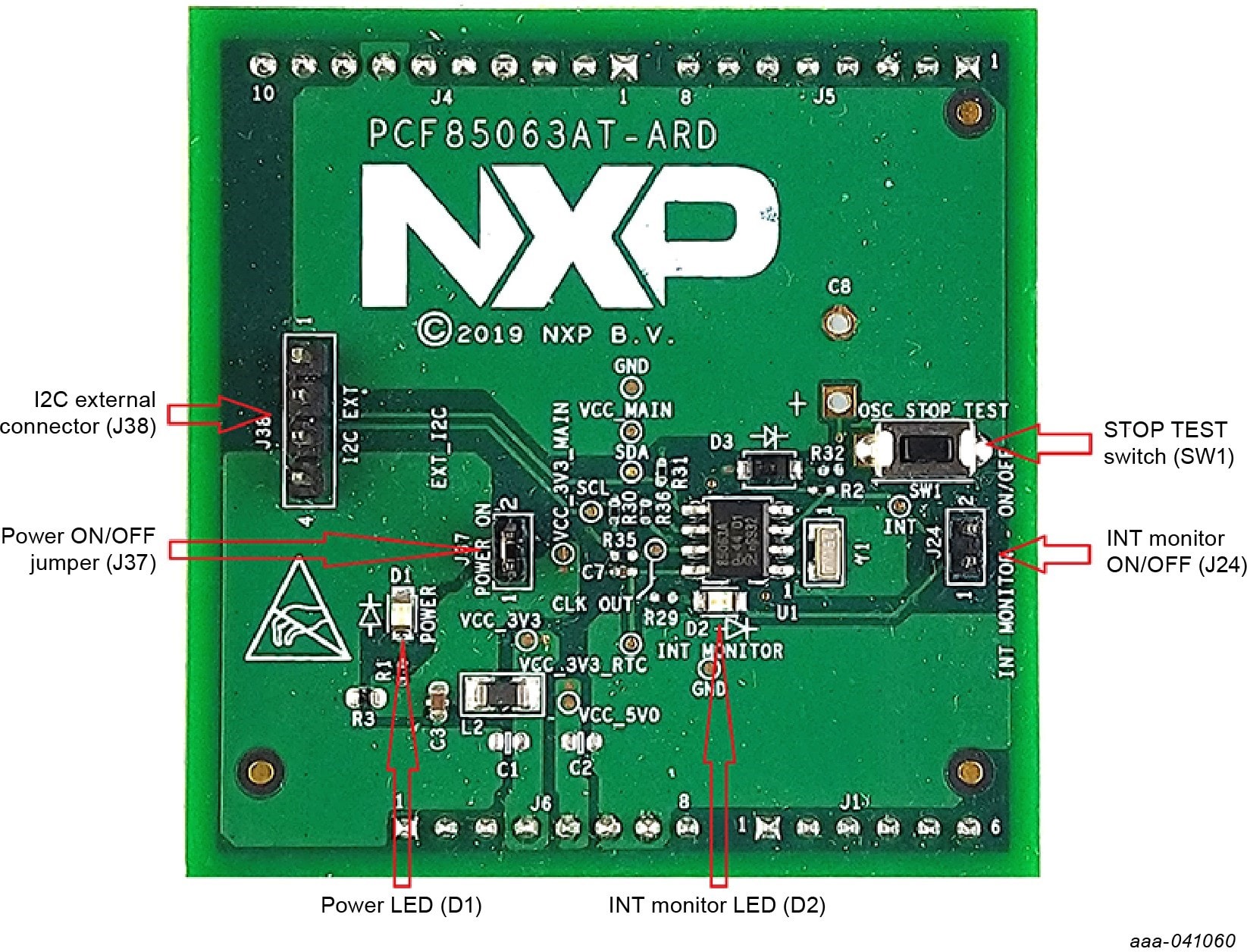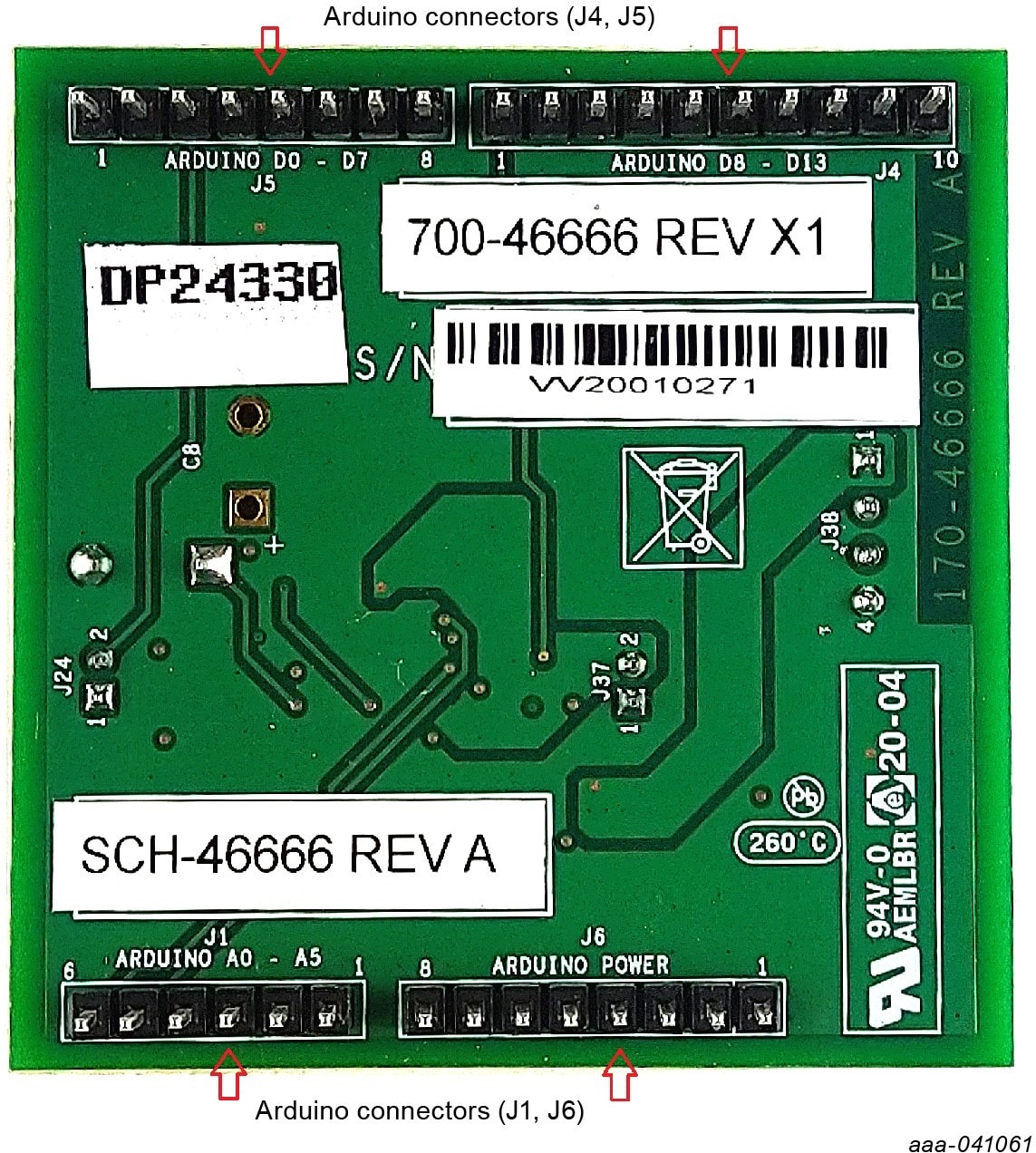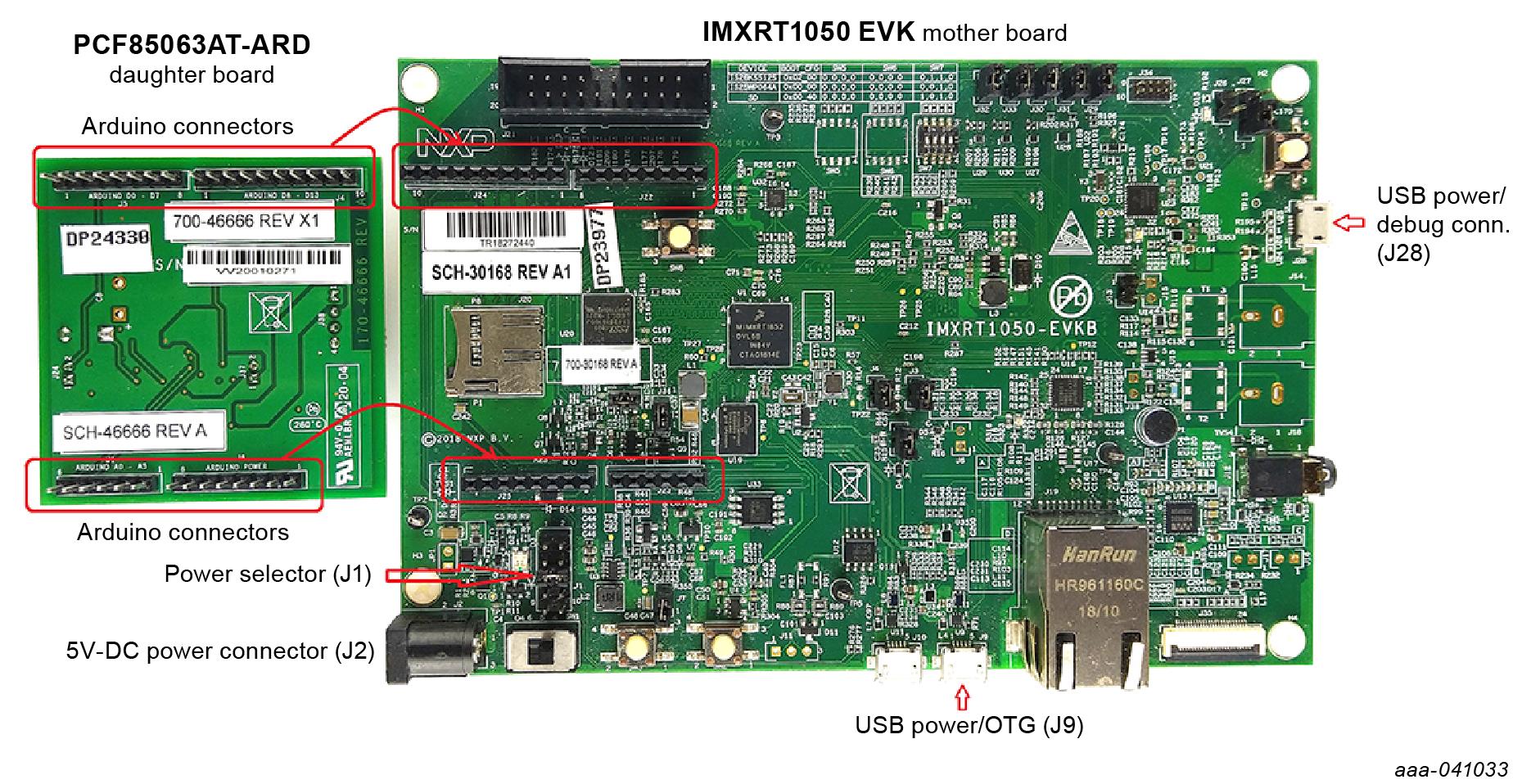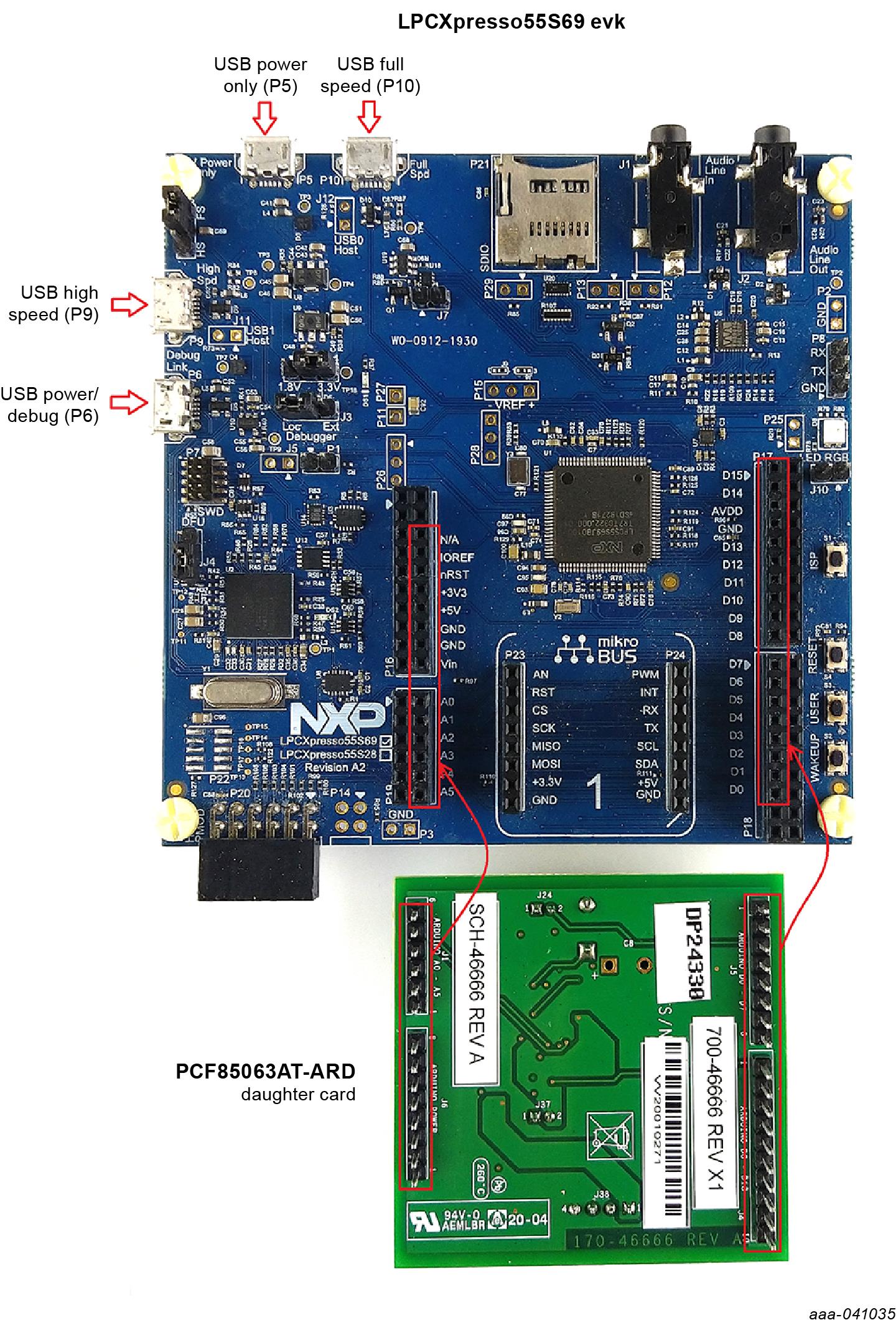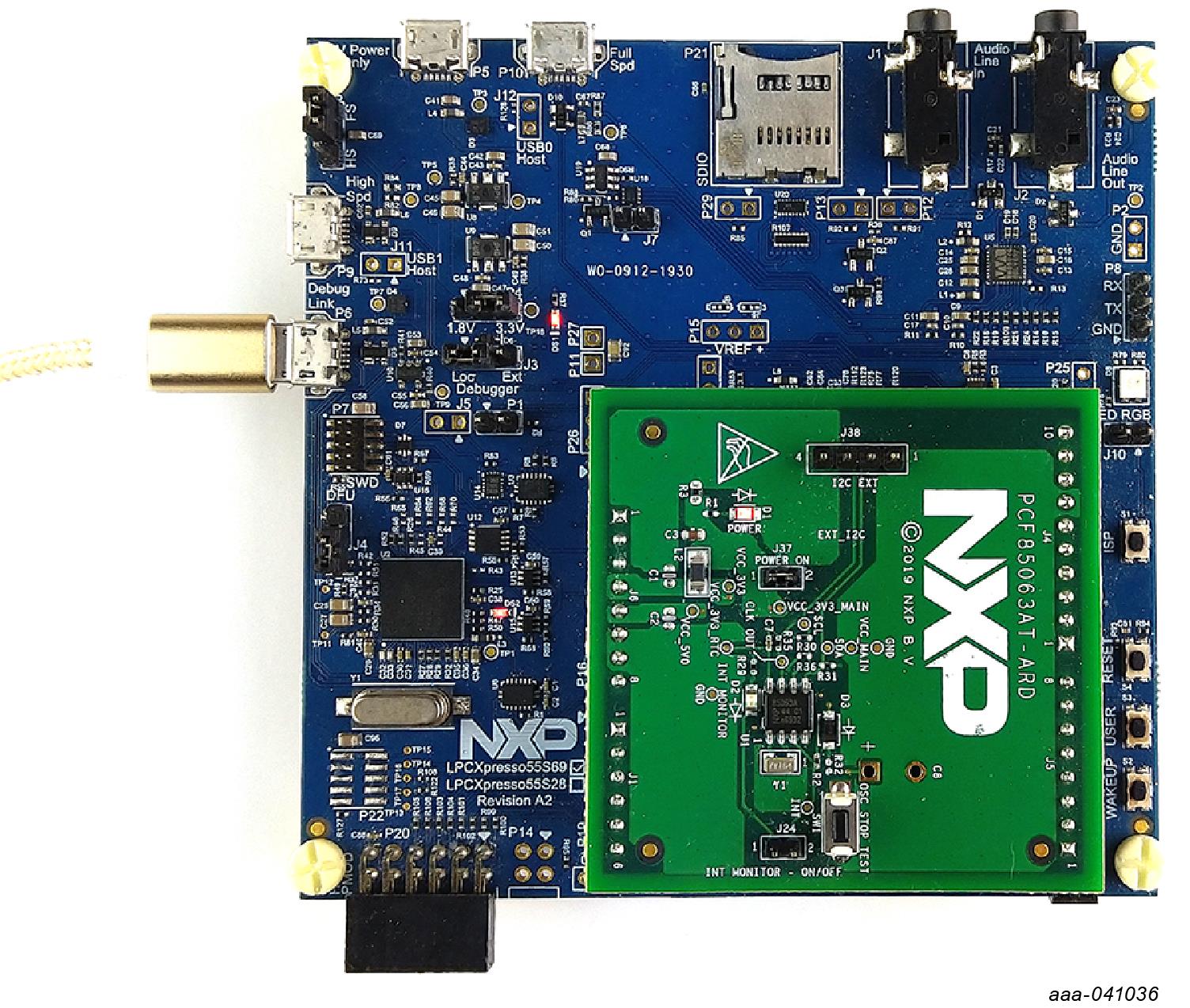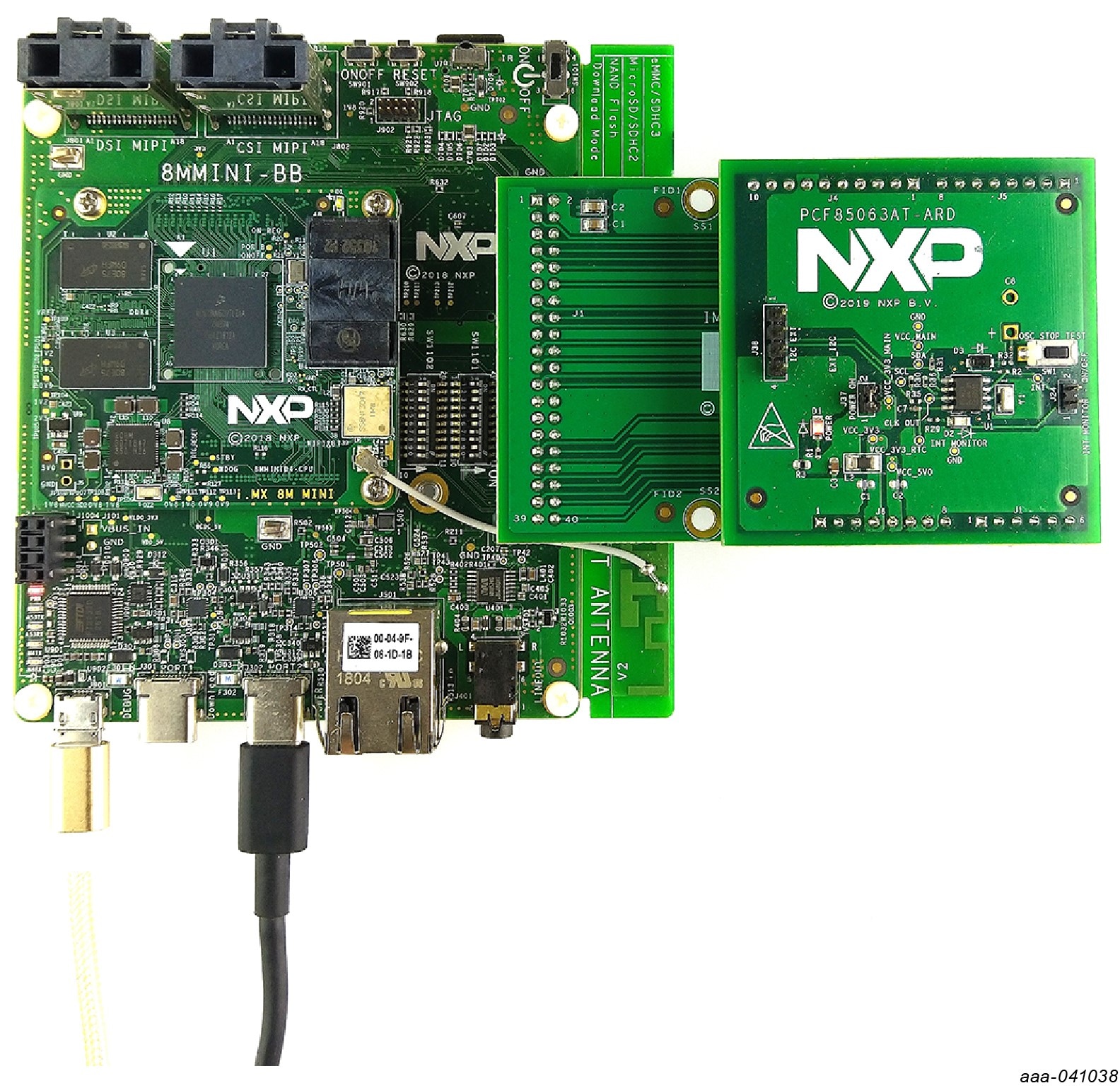- Analog Toolbox
- Getting Started with the PCF85063AT-ARD Evaluation Board
Getting Started with the PCF85063AT-ARD Evaluation Board
Contents of this document
-
Get Started
-
Get to Know the Hardware
-
Install Software
-
Configure the Hardware
Sign in to save your progress. Don't have an account? Create one.

Purchase your PCF85063AT-ARD Arduino® Shield - Tiny Real-Time Clock
1. Get Started
The NXP analog product development boards provide an easy-to-use platform for evaluating NXP products. The boards support a range of analog, mixed-signal and power solutions. They incorporate monolithic integrated circuits and system-in-package devices that use proven high-volume technology. NXP products offer longer battery life, a smaller form factor, reduced component counts, lower cost and improved performance in powering state-of-the-art systems.
This page will guide you through the process of setting up and using the PCF85063ATARD evaluation board.
1.1 Kit Contents/packing List
The PCF85063AT-ARD contents include:
- Assembled and tested evaluation board in an anti-static bag
- Quick start guide
1.3 Static Handling Requirements
This device is sensitive to ElectroStatic Discharge (ESD). Therefore care should be taken during transport and handling. You must use a ground strap or touch the PC case or other grounded source before unpacking or handling the hardware.
1.4 Minimum System Requirements
This evaluation board requires a Windows PC workstation. Meeting these minimum specifications should produce great results when working with this evaluation board.
- Computer with Windows 10
- One of three EVKs boards (MIMXRT1050-EVK, LPC55S69-EVK, 8MMINILPD4-EVK) along with the associated firmware / GUI software
- USB cable for power and data connection between PC and EVK board (if it is not included in the EVK package)
2. Get to Know the Hardware
2.1 Board Features
- Connector for external access to I²C-bus
- Onboard user switch for oscillator stop test
- Onboard LED for interrupt pin monitoring
- Equipped with Arduino Uno R3 port for direct connection with Arduino devices
- Fully compliant with MIMXRT1050-EVK board, including GUI (Windows 10)
- Fully compliant with LPC55S69-EVK board, including GUI (Windows 10)
- Compliant with 8MMINILPD4-EVK board, including GUI (Windows 10)
2.2 Board Description
The evaluation board is built around the PCF85063AT IC and works as a daughter card. The card can be connected through an Arduino port to various Arduino compatible (including original Arduino Uno R3) boards. The board is intended to test and measure the characteristics of the PCF85063A tiny real-time clock/calendar with alarm function and I²C-bus, supported by NXP Semiconductors.
The RTC communicates with the controller / microprocessor through a bidirectional Fm I²C-bus. Among the device under test (DUT) IC, the board is equipped with an Arduino port and the necessary components for easy testing, shortening the time to make measurements and check operation of the PCF85063AT IC.
Additionally, the expansion board has software support and a graphical user interface (Windows platform) for the following NXP evaluation boards: MIMXRT1050-EVK board, LPC55S69-EVK development board and 8MMINILPD4-EVK board.
3. Install Software
PCF85063AT-ARD evaluation board is designed and built as a expansion board able to work with a mother board equipped with an Arduino port. The board is built to be fully compatible with the following NXP evaluation boards:
The required firmware for the EVK boards is available for download at NXP site. Before starting a pair EVK - PCF85063AT-ARD, the EVK motherboard must be programmed with the corresponding firmware package. Additionally, a GUI application (Windows 10) is available for download from the same NXP site, allowing rapid testing and operation of PCF85063AT-ARD expansion board through one of the EVKs.
The GUI application is common for all three EVKs and for the PCF85x63 RTC development card family, manufactured by NXP (PCF85063AT, PCF85063TP and PCF85263ATL ICs). For details regarding installation of the EVK firmware and GUI host software, see UM11581 , Arduino shields GUI and firmware installation manual.
Once the software is installed, the first step is to select the correct EVK from the graphical interface. The board can then be controlled from the GUI interface.
4. Configure the Hardware
4.1 Using PCF85063AT-ARD with MIMXRT1050-EVK board
Figure 1 shows the required hardware for operation of the PCF85063AT-ARD expansion board with MIMXRT1050-EVK.
- One MIMXRT1050-EVK board
- One PCF85063AT-ARD expansion board
- One USB-A / USB Micro-B cable
- PC with Windows 10 operating system
The MIMXRT1050-EVK mother board can be powered through three different connectors: using an external 5.0 V DC power
supply, connected to J2 barrel power connector, directly from a USB port through J9 USB
Micro-B connector (J9), or from the same USB port through J28 connector. J28
can be used as a debug connector, therefore using J28, through the same USB cable, the EVK can be
powered and in the same time linked to PC for data exchange. The older USB ports (from PC) are not able to deliver
the necessary current (500 mA), before establishing the communication, use an external power supply (connected to
J2). From J1 (see Figure 1), the user can select the power configuration for the mother
board. For more details, see i.MX RT1050 Evaluation Kit.
To configure the hardware and workstation, complete the following procedure:
- Configure the suitable power configuration of EVK (
J1). If the user is using J28 for power supply, theJ1jumper is placed in position 5-6. If the user uses an external power supply (connected toJ2), the jumperJ1is placed in position 1-2 - Insert the PCF85063AT-ARD daughter card on the Arduino port of the EVK (see Figure 1)
- Connect the MIMXRT1050-EVK board using
J28connector to USB port of the computer - Install the IMXRT1050 target firmware (download from NXP site and see UM11581 for step-by-step instructions)
- Install GUI application on PC (see UM11581 , Arduino shields GUI and firmware installation manual)
- Open the GUI application to operate the device from the PC
4.2 Using PCF85063AT-ARD with LPC55S69-EVK board
Figure 3 shows the required hardware for operation of the PCF85063AT-ARD and LPC55S69-EVK board.
- One LPC55S69-EVK board
- One PCF85063AT-ARD expansion board
- One USB-A / USB Micro-B cable
- PC with Windows 10 operating system
The LPC55S69-EVK board is equipped with four USB Micro-B connectors: P5, P6,
P9 and P10. The board can be powered through any USB port. Using P6 USB connector to
connect the board to the PC, the bring-up operation is simplified because P6 is designated for debug,
and the USB cable accomplishes two tasks in the same time: powering the board, and data link between the
LPC55S69-EVK board and PC. For more details, see LPCXpresso55S69 Development Board.
To configure the hardware and workstation, complete the following procedure:
- Insert the PCF85063AT-ARD daughter card to
P16-P19connectors located on LPC55S69-EVK development board (see the marked pins ofP16-P19, Figure 3) - Connect the development board using port
P6USB port of PC - Install the LPCXpresso55S69 target firmware (download from NXP site and see UM11581 for step-by-step instructions)
- Install GUI application on PC (see UM11581 , Arduino shields GUI and firmware installation manual)
- Open the GUI application to operate the device from the PC
4.3 Using PCF85063AT-ARD with 8MMINILPD4-EVK Board
If 8MMINILPD4-EVK board is used for PCF85063AT-ARD operation, a third board (IMX8MMINI-IARD interposer board) must be
used, especially designed and built as EVK - expansion board interconnection. The EVK board 8MMINILPD4-EVK is not
equipped with Arduino port, instead has a 2x20 pin expansion connector (J1003, see 8MMINILPD4-EVK user
manual). J1003 is a multipurpose port, containing different digital I/O lines, including specialized
I²C and SPI buses. Starting from the expansion connector pin chart, an Arduino port interposer board was
developed.
In Figure 5 it can be easy to observe, along the EVK and expansion board a third board is included in the setup
assembly. This is IMX8MMINI-IARD interposer board. To power up and operate the setup. It is also necessary to have
one USB-C cable for power (see picture in Fig. 9), connected to Port 2 of the EVK board. The board is equipped with
power switch (SW101) which shall be positioned in ON position to power up the setup. Data communication
is assured through a second (USB Micro-B) cable connected to PC and debug port of the EVK (J901).
To attach the expansion board to the EVK, it is necessary to use the IMX8MMINIIARD interposer boards by plugging
PCF85063AT-ARD to the Arduino connector of the interposer, and then the interposer to expansion connector
(J1003), located on the i.MX8MMINI EVK board (see Figure 5). The user may find more details regarding
power-up and operation of the setup assembly, in 8MMINILPD4-EVK user manual (IMX8MMEVKHUG.pdf) and IMX8MMINI-IARD
user manual. The files can be downloaded from NXP site.
To configure the hardware and workstation, complete the following procedure:
- Insert the PCF85063AT-ARD on IMX8MMINI-IARD interposer board Arduino connectors (located on the top side)
- Attach the obtained assembly to EVK (plug
J1connector of IMX8MMINI-IARD, located on the bottom side intoJ1003expansion board located on the top side of 8MMINILPD4-EVK board) - Power up the EVK board using a USB Type C cable attached to Port 2
- Connect the EVK to the PC, using a USB Micro-B cable, attached to
J901debug port - Place
SW101in On position to power up the boards. - Install the MIMXRT1050 target firmware (download from NXP site and see UM11581 for step-by-step instructions)
- Install GUI application on PC. Note that an additional USB driver from FTDI Chip
(
ftdichip.com/drivers/d2xx-drivers) should be installed - Open the GUI application, to operate the device from the PC
4.4 Using PCF85063AT-ARD with another Arduino device
The PCF85063AT-ARD expansion board can be operated with different EVK boards, which has an Arduino port. There are two options to connect the board: using other EVK equipped with an Arduino port, and an EVK without Arduino port.
In the first case, a firmware is developed according to PCF85063AT specifications, and then PCF85063AT-ARD expansion board is attached to the EVK to operate the board.
In the second case, using the pin chart of Arduino connectors, make the necessary electrical connections (for power, I²C-bus and control lines), and develop the desired firmware compliant with IC specifications. Use PCF85063A data sheet to read details about internal registers of PCF85063AT and data exchange between internal controller and the EVK. Ensure that the electrical connections are accurate and avoid data conflicts on the signal lines, in order to prevent IC damage.
Design Resources
On this page
- 1.1
Kit Contents/packing List
- 1.2
Assumptions
- 1.3
Static Handling Requirements
- 1.4
Minimum System Requirements
